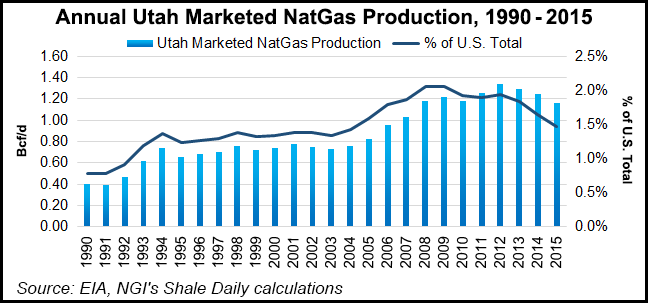E&P | NGI The Weekly Gas Market Report
Judge Rejects BLM Gas Drilling Program in Uintah Basin
A federal judge in Utah has rejected the U.S. Bureau of Land Management’s (BLM) approval of a natural gas drilling program in the Uintah Basin, saying the environmental review was insufficient given that thousands of wells were potentially going to be drilled under the plan.

In the ruling, BLM is charged with updating its air quality analysis and considering noise impacts in the Green River recreation area before reconsidering the decision.
U.S. District Court Magistrate for the District of Utah Evelyn Furse in a 30-page ruling said BLM failed to adequately consider the adverse effect on rural air quality in the decision approving a 16-well gas drilling project proposed by Denver-based Gasco Energy. The judge cited the National Environmental Policy Act as requiring federal land managers to “accurately account for environmental impact of all reasonably foreseeable actions.”
The ruling came within a day of another Utah BLM decision involving the Uintah Basin, in which a 20-year oil/gas drilling program was given the green light, issuing a record of decision (ROD) for up to 5,800 infill wells on federal, state and private lands south of Myton, UT (see Shale Daily, Oct. 3).
Utah Gov. Gary Herbert has recommended that portions of the Uintah where the elevation is under 6,000 feet be designated as out of attainment for the federal ozone standard. If the federal regulators designated it as a nonattainment area, emissions would have to be further reduced in future oil and gas operations, which are expected to increase following the two-year lows in commodity prices.
Nevertheless, Salt Lake City-based BLM officials told NGI Thursday that the ROD has not been affected by the latest court decision regarding Gasco.
“Addressing air quality concerns in the Uintah Basin was at the forefront of the Monument Butte planning effort, and the BLM views the ROD as a model for responsible energy development, which we plan to use for future projects,” said BLM spokesman Ryan Sutherland.
To underscore its point, BLM cited the 60 pages of mitigation measures in Monument Butte to which Newfield committed, along with other environmental protection and monitoring requirements. Through negotiations, Newfield also committed to a “net-zero” increase in overall volatile organic compound emissions, which are a ozone precursor.
Part of the collaboration among BLM, Newfield, the U.S. Environmental Protection Agency, state of Utah and U.S. Fish and Wildlife Service developed an air quality mitigation strategy that BLM calls unprecedented.
With an eye toward increased future activity in the Uintah, BLM in addition to the recent Gasco proposal is reviewing a Crescent Point Energy plan for 3,925 wells spread over 115,000 acres east of Myton and northeast of Newfield’s play.
Previously, BLM authorized Gasco’s plans for 1,300 wells in the southeast corner of the Uintah (see Shale Daily, June 20, 2012), prompting the Southern Utah Wilderness Alliance and The Wilderness Society to file a lawsuit over wells being sited too close to a designated wilderness area.
The court ruling Monday only pertains to Gasco’s first site-specific program under the overall 207,000-acre gas field, focusing on only 16 gas wells slated for three existing pads. Nevertheless, it could serve as a test case for future development, some observers contend.
© 2024 Natural Gas Intelligence. All rights reserved.
ISSN © 1532-1266 | ISSN © 2158-8023 |
